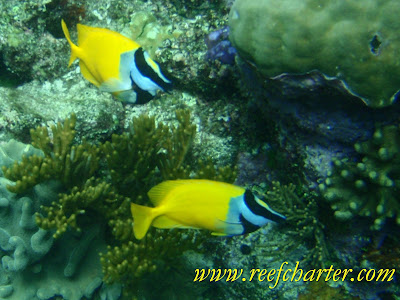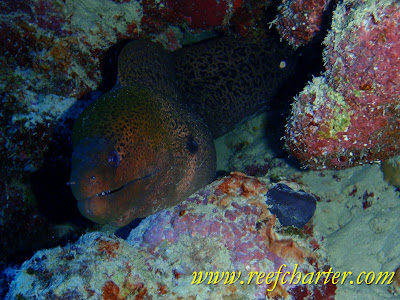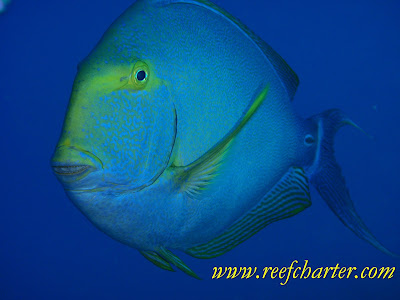The foxface or rabittfish was given it’s name from their small, rabbit-like mouths, large dark eyes, and a shy temperament.
The rabbitfish or foxface is an active algae eater on the Great Barrier Reef. They are often seen along with butterfly fish cleaning the coral and reef base. The Foxface grows to about 40cm (16″) long. Their bright and distinct colour bands make them very popular with aquarium owners, they are also relatively easly to keep in aquariums. Often vegetables are added to their diet while they are kept in aquariums.
Rabbitfish also have poisonous spines in their dorsal fins and will use them to protect themselves if they feel threatened. So do not touch or aggrevate these fish. They are also timid fish and will flee if at all possible so this is mainly an issue only in the aquarium environment.
Category: Fish
Moray Eels – Species of the Reef
There are over 200 different types of Moray Eels around the world, living in a number of different environments. The smallest moray is about 12cm (5 inches) and the longest is about 4m (13 feet) long. The largest variety of the species being found in warm tropical waters and reefs with diversity lessening as the water becomes cooler.
The Moray Eel relies on camouflage and smell to catch its food as it has relatively poor eyesight. It lies in crevaces and waits for its next meal to swim past. To assist with hiding even the inside of the mouth is coloured to fit in with its surroundings. This also allows the moray to lie in waiting with its mouth open to get little warning to the unsuspecting prey. The moray eel also has a second set of jaws that move forward when attacking and give the eel some extra grip on the prey. This second set of jaws also help pass the food down to the stomach of the ray.
There are only a few predators of the moray eel, they include the barracuda, Groupers, Sea Snakes and other Moray Eels. The Moray itself is carnivorous and eats just about anything.
The Morays have sometimes been described as vicious or ill-tempered, this is not a deserved reputaiton as Morays hide from humans and would rather flee than fight. Morays are shy and secretive, and attack humans only in self-defense or mistaken identity (for example, a finger placed in a crevice where a moray resides may resemble a prey-item). Most attacks involve accidental bites during human-initiated interaction.
Surgeon Fish – Species of the Reef
A colourful and common sight on the Great Barrier reef is the surgeon fish, like the yellow fin surgeon fish pictured above. The distinctive characteristic of the family is the spines, one or more on either side of the tail. Both the dorsal and tail fins are large, extending for most of the length of the body. The small mouths have a single row of teeth used for grazing on algae.
Surgeonfishes sometimes feed by themselves, but they are also often seen traveling and feeding in large colourful schools. It has been suggested that feeding in schools is a mechanism for overwhelming the highly aggressive defense responses of small territorial damselfishes that vigorously guard small patches of algae on coral reefs.
Most species are relatively small and have a maximum length of 15–40 cm (6–16 in), but some members of the genus Acanthurus, some members of the genus Prionurus, and most members of the genus Naso can grow larger, with the whitemargin unicornfish (N. annulatus), the largest species in the family, reaching a length of up to a meter (3,3 ft). These fishes can grow quickly in aquariums so it is advisable to check the average growth size and suitability before adding to a marine aquarium.
White Tip Reef Shark – Species of the Reef
This is the most common shark spotted by our guests, whether they are snorkeling or scuba diving. The white tip reef shark is a relatively small shark. The average size only measuring about 1.8 metres or 6 feet long. This is one of the best parts of our jobs, seeing people who less then 30 minutes ago were scared about sharing the water with a shark. Now they are seeing them up close and experiencing sharks in their natural habit. Immediately realizing that all the television and movie myths are just that myths. One of our guests last year went from being a nervous snorkeller to scuba diving, and her reason I want to ‘dive with the sharks’.
As you can see from the photo above, all sharks do not require to keep swimming to stay alive, this again is another myth. White Tip Sharks can move water through their gills as they lay still on the bottom. This species of shark tends to hang around reefs for long periods of time, sometimes years. They hunt at night feeding on octopus, fish and other reef creatures, including lobsters and crabs. Not a bad diet. During a night dive, you can observe them slowly swimming along the reef edge looking for that evening snack. Unlike other shark species they do not get into a feeding frenzy.
They are not aggressive towards humans at all, unless provoked and then purely a defensive measure. Humans feeding sharks can lead to confusion and sharks may mistakenly grab the hand that feeds it. Another good reason not to feed the fish, especially the big ones with big teeth.
White Tip Sharks pregnancy lasts about 10-12 months. They give birth to young called pups, this litter can contain anything up to 6 pups. Now how did the white tip shark get its name? Very easy, the white tips on the tops of the fins.
Current populations of white tip sharks are depleting at the rate of about 8% per year, due to unsustainable fishing practices in other parts of the world and its slow reproductive rate.
Swimming and diving with sharks that you must experience to really appreciate. The only way to dispel the myths and see the grace and beauty of a shark it to come and experience it in the sharks natural habitat.





